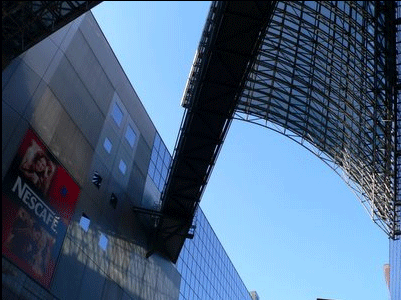 On Dec. 12, 2005, we arrived at Kansai with the Sun low on the horizon, casting orange shafts through the plane. Whitecaps were frothing on the Inland Sea. The airport is built on two 4 kilometer by 1 kilometer artificial islands, and is connected to Honshu by a 3 kilometer bridge that cost 100 billion yen. Beneath the vast new terminal, an attendant with a pressed shirt and tie helped us navigate the ticket machines to buy two Haruka Ltd. express tickets to Kyoto. The bullet train pulled away as soon as we stepped on, gliding glass-smooth through the night blur of an endless city.
On Dec. 12, 2005, we arrived at Kansai with the Sun low on the horizon, casting orange shafts through the plane. Whitecaps were frothing on the Inland Sea. The airport is built on two 4 kilometer by 1 kilometer artificial islands, and is connected to Honshu by a 3 kilometer bridge that cost 100 billion yen. Beneath the vast new terminal, an attendant with a pressed shirt and tie helped us navigate the ticket machines to buy two Haruka Ltd. express tickets to Kyoto. The bullet train pulled away as soon as we stepped on, gliding glass-smooth through the night blur of an endless city.
That night, in a room in the hyper-modern Hotel Granvia, I lay awake, jet lagged and alert, listening to the faint rush of warm air flowing from a network of unseen ducts. Outside, the lights of the city were a panoply of mysterious characters and sparkling complexity, illuminating blocks of buildings that stretched away in all directions to the dark mountainous horizon. I was suddenly brought around to a simple fact that I always find startling:
No one arrived from outer space to build all this. In a very real sense, the planet Earth has done has done all this itself.
At the base of a skyscraper, you sense the tremendous weight of the building, and indeed, this is because you are standing at the base of a very steep cliff. A skyscraper is part of the relief of the Earth’s surface. It is a landform, albeit with a peculiar geological history.

Fourteen thousand years ago, the middle latitudes of the northern hemisphere were buried beneath thousands of feet of glacial ice. Then, over the space of a few thousand years, the Earth began to experience a dramatic series of changes. Global temperatures underwent a rapid rise, the ice melted, and the glaciers retreated, leaving behind flat boulder-strewn plains spotted with cold lakes. A sea of grass soon spread across the entire middle third of the North American continent. Thousands of generations of grass sprouting on the poorly drained land built up a black veneer of topsoil.
Roughly a hundred years ago, a mountain range began to rise up at the southwest corner of Lake Michigan. The highest peaks of the range now reach heights of 2500 feet above sea level. The eastern face of the range juts directly up from the lakeshore, and like all fast-growing mountains, the peaks are steep and faceted, interspersed with deep-cut canyons. Similar geologic processes have given rise to ranges of roughly equal height on Manhattan Island, on the San Francisco Peninsula, and ringing Osaka Bay.
One can protest that the growth of cities is completely different from the mindless subduction, faulting, and folding of the crust that gave rise to the Andes or the Appalachians, but skyscrapers are mountains nonetheless. They are areas of steep relief that the Earth has produced. They offer something new and wholly unprecedented. For billions of years, the surface of the Earth was sculpted at rates that corresponded to fractions of an inch per year. The Sears tower, by contrast, soared up nearly 2000 feet in only two years. Concrete paving resurfaces the land at a rate far greater that any lava flow of the past billion years.
If we step back from out anthropic perspective, the growth of cities on Earth can be viewed as a geological process. The Earth built them itself. Within the past few hundred years, and especially within the last century, directed processes have suddenly emerged as a potent geological force.
In this same sense, the Earth is already altering the dynamics of the entire solar system. The launches of rockets have induced tiny changes in Earth’s orbit. Because the orbital dynamics of the planets are chaotic, these minute alterations will magnify over time, and within a billion years, the positions of the planetary orbits will be completely different from where they would have been had the astronauts stayed home.
Perhaps even more significantly, the Earth has fashioned together tiny pieces of the metal in its crust, and has flung these delicately constructed objects at all of the planets in the solar system. While Jupiter, Saturn and the other worlds orbit mute and unresponsive, the Earth has suddenly lurched into action. There exists a possible solution to the long-term dynamics of the Solar System that Newton, Laplace, and even Poincare never dreamed of.

Pingback: systemic - rates